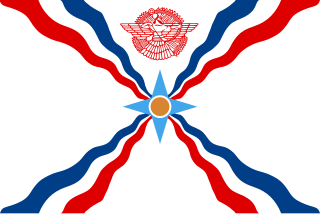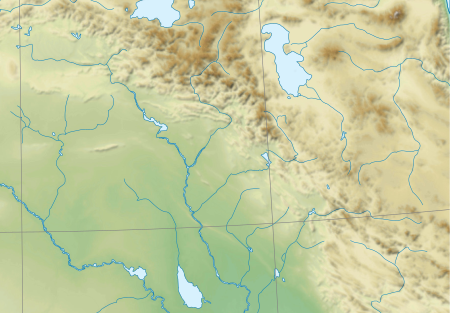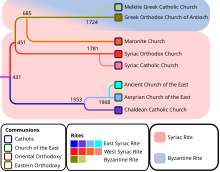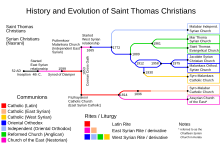Aramaic is a language that originated among the Arameans in the ancient region of Syria, at the end of the 2nd millennium BC, and later became one of the most prominent languages of the ancient Near East. During its three thousand years long history, Aramaic went through several stages of development. It has served as a language of public life and administration of ancient kingdoms and empires, and also as a language of divine worship and religious study. It subsequently branched into several Neo-Aramaic languages that are still spoken in modern times.

Assyrians also known as Syriacs/Arameans or Chaldeans are an ethnic group indigenous to the Middle East. They are speakers of the Neo-Aramaic branch of Semitic languages as well as the primary languages in their countries of residence, modern Assyrians are Syriac Christians who claim descent from Assyria, one of the oldest civilizations in the world, dating back to 2500 BC in ancient Mesopotamia.
Turoyo (Ṭūroyo), also referred to as modern Surayt (Sūrayṯ), or modern Suryoyo (Sūryōyō), is a Central Neo-Aramaic language traditionally spoken in the Tur Abdin region in southeastern Turkey and in northern Syria. Turoyo speakers are mostly adherents of the Syriac Orthodox Church, but there are also some Turoyo-speaking adherents of the Assyrian Church of the East and the Chaldean Catholic Church, especially from the town of Midyat. The language is also spoken throughout diaspora, among modern Arameans and Assyrians. It is classified as a vulnerable language. Most speakers use the Classical Syriac language for literature and worship. Turoyo is not mutually intelligible with Western Neo-Aramaic, having been separated for over a thousand years; its closest relatives are Mlahso language and western varieties of Northeastern Neo-Aramaic.

Chaldean Neo-Aramaic, or simply Chaldean, is a Northeastern Neo-Aramaic language spoken throughout a large region stretching from the Nineveh plains, in northern Iraq, together with parts of southeastern Turkey.
Assyrian Neo-Aramaic or simply Assyrian, also known as Syriac, Eastern Syriac, Neo-Syriac and Modern Syriac, is an Aramaic language within the Semitic branch of the Afro-Asiatic language family that is spoken by the Assyrian people. The various Assyrian dialects descend from Old Aramaic, the lingua franca in the later phase of the Assyrian Empire, which slowly displaced the East Semitic Akkadian language beginning around the 10th century BC. They have been further heavily influenced by Classical Syriac, the Middle Aramaic dialect of Edessa, after its adoption as an official liturgical language of the Syriac churches.
Zakho Jewish Neo-Aramaic is a dialect of Northeastern Neo-Aramaic originally spoken by Jews in northern Iraq and southeastern Turkey in the lands west of the Great Zab. Following the exodus of Jews from the Muslim lands, most speakers now live in Israel, principally Jerusalem and surrounding villages.
Urmia Jewish Neo-Aramaic is a dialect of Northeastern Neo-Aramaic was originally in Urmia and surrounding areas Iranian Azerbaijan, from Salmas to Solduz and into what is now eastern Turkey, Yüksekova and Başkale. Most speakers now live in Israel.
Inter-Zab Jewish Neo-Aramaic is a modern Jewish-Aramaic dialect, a variant of Northeastern Neo-Aramaic. It was originally spoken in Kurdistan Region of Iraq, in and around Arbil between the Great Zab and Little Zab rivers. Most speakers now live in Israel.
Trans-Zab Jewish Neo-Aramaic, also known as Hulaulá, is a grouping of related dialects of Northeastern Neo-Aramaic originally spoken by Jews in Iranian Kurdistan and easternmost Iraqi Kurdistan. Most speakers now live in Israel.
Hertevin is a dialect of Northeastern Neo-Aramaic originally spoken by Chaldean Catholics in a cluster of villages in Siirt Province in southeastern Turkey. Speakers of Hértevin Aramaic have emigrated mostly to the West, and are now scattered and isolated from one another. A few speakers remain in Turkey. The closest related language variety is Bohtan Neo-Aramaic. Hertevin also shares many similarities with Turoyo.
Koy Sanjaq Christian Neo-Aramaic is a variety of Northeastern Neo-Aramaic spoken by Christian Assyrians in Koy Sanjaq in the Erbil Governorate, Iraq. Koy Sanjaq Jewish Neo-Aramaic is a separate variety spoken by Jews in the same town. The Madnhâyâ version of the Syriac alphabet is used in writing, but most written material is in the Syriac language used in worship.

Judaeo-Aramaic languages represent a group of Hebrew-influenced Aramaic and Neo-Aramaic languages.
Bohtan Neo-Aramaic is a dialect of Northeastern Neo-Aramaic originally spoken by ethnic Assyrians on the plain of Bohtan in the Ottoman Empire. Its speakers were displaced during the Assyrian genocide in 1915 and settled in Gardabani, near Rustavi in Georgia, Göygöl and Ağstafa in Azerbaijan. However it is now spoken in Moscow, Krymsk and Novopavlosk, Russia. It is considered to be a dialect of Assyrian Neo-Aramaic since it is a northeastern Aramaic language and its speakers are ethnically Assyrians.
The Neo-Aramaic or Modern Aramaic languages are varieties of Aramaic, that evolved during the late medieval and early modern periods, and continue to the present day as vernacular (spoken) languages of modern Aramaic-speaking communities. Within the field of Aramaic studies, classification of Neo-Aramaic languages has been the subject of a particular interest among scholars, who proposed several divisions, into two, three or four primary groups.
Central Neo-Aramaic languages represent a specific group of Neo-Aramaic languages, that is designated as Central in reference to its geographical position between Western Neo-Aramaic and other Eastern Aramaic groups. Its linguistic homeland is located in northern parts of the historical region of Syria. The group includes the Turoyo language as a spoken language of the Tur Abdin region and various groups in diaspora, and Mlahsô language that is recently extinct as a spoken language.
Northeastern Neo-Aramaic (NENA) is a grouping of related dialects of Neo-Aramaic spoken before World War I as a vernacular language by Jews and Christians between the Tigris and Lake Urmia, stretching north to Lake Van and southwards to Mosul and Kirkuk. As a result of the Sayfo Christian speakers were forced out of the area that is now Turkey and in the early 1950s most Jewish speakers moved to Israel. The Kurdish-Turkish conflict resulted in further dislocations of speaker populations. As of the 1990s, the NENA group had an estimated number of fluent speakers among the Assyrians just below 500,000, spread throughout the Middle East and the Assyrian diaspora. In 2007, linguist Geoffrey Khan wrote that many dialects were nearing extinction with fluent speakers difficult to find.
Mar Youhannan Semaan Issayi ;1999)) was the Metropolitan Archbishop of Tehran of the Chaldean Catholics from March 16, 1971, until his death on February 7, 1999. He was born in Sanandaj سنندج, Kurdistan Iran on June 27, 1914, and ordained priest on March 3, 1940, and consecrated bishop on, October 22, 1967, in Iran.
The Eastern Aramaic languages have developed from the varieties of Aramaic that developed in and around Mesopotamia, as opposed to western varieties of the Levant. Most speakers are ethnic Assyrians, although there are a minority of Kurdish Jews and Mandaeans, who also speak varieties of Eastern Aramaic.

Assyrian continuity is the theory—supported by some scholars and modern Assyrians—that today's Assyrians descend from the ancient Assyrians, a Semitic people native to ancient Assyria, that originally spoke ancient Assyrian language, a dialect of Akkadian language. Notions of Assyrian continuity are based on both ethnic, genetic, linguistic and historical claims, and the asserted continuity of Assyria's historical and cultural heritage after the fall of the ancient Assyrian Empire.
Estiphan Panoussi is a philologist, philosopher, orientalist, and international scholar of Iranian Assyrian (Aramaic) origin. He is professor emeritus of the University of Gothenburg and native speaker of Senaya, a Northeastern Neo-Aramaic language.









